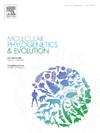用于系统发育推断的蛋白质进化替代模型的趋势。
IF 3.6
1区 生物学
Q2 BIOCHEMISTRY & MOLECULAR BIOLOGY
引用次数: 0
摘要
蛋白质进化的替代模型描述了氨基酸之间的进化变化速率,对各种进化研究至关重要,包括重建系统发育历史和祖先序列等。最早的蛋白质进化替代模型是基于经验蛋白质序列的,尽管他们的假设不切实际,但仍然经常用于蛋白质系统发育。接下来,结合关于蛋白质稳定性和蛋白质功能的进化约束的其他参数,显著提高了建模的准确性。然而,尽管提出了各种各样的蛋白质进化替代模型,但只有一小部分模型已在系统发育学中实际使用的进化框架中实现。在这里,我们概述了蛋白质进化替代模型的发展和应用的总体趋势,包括它们的理论基础,目标,改进的领域,以及在系统发育框架中的实现。我们还提供了使用先进的结构约束替代模型进行系统发育推断的详细实例。本文章由计算机程序翻译,如有差异,请以英文原文为准。

Trends in substitution models of protein evolution for phylogenetic inference
Substitution models of protein evolution describe the rates of evolutionary change among amino acids and are essential for a variety of evolutionary studies, including the reconstruction of phylogenetic histories and ancestral sequences, among others. The earliest substitution models of protein evolution are based on empirical protein sequences and, despite their unrealistic assumptions, are still routinely used in protein phylogenetics. Next, the incorporation of additional parameters that inform about evolutionary constraints on protein stability and protein function provided a significant increase in the accuracy of the modeling. However, despite the wide variety of substitution models of protein evolution that were presented, only a small subset has been implemented in evolutionary frameworks of practical use in phylogenetics. Here, we overview general trends in the development and application of substitution models of protein evolution, including their theoretical fundamentals, goals, areas for improvement, and implementation in phylogenetic frameworks. We also provide detailed practical examples of phylogenetic inference using advanced structurally constrained substitution models.
求助全文
通过发布文献求助,成功后即可免费获取论文全文。
去求助
来源期刊
CiteScore
7.50
自引率
7.30%
发文量
249
审稿时长
7.5 months
期刊介绍:
Molecular Phylogenetics and Evolution is dedicated to bringing Darwin''s dream within grasp - to "have fairly true genealogical trees of each great kingdom of Nature." The journal provides a forum for molecular studies that advance our understanding of phylogeny and evolution, further the development of phylogenetically more accurate taxonomic classifications, and ultimately bring a unified classification for all the ramifying lines of life. Phylogeographic studies will be considered for publication if they offer EXCEPTIONAL theoretical or empirical advances.

 求助内容:
求助内容: 应助结果提醒方式:
应助结果提醒方式:


